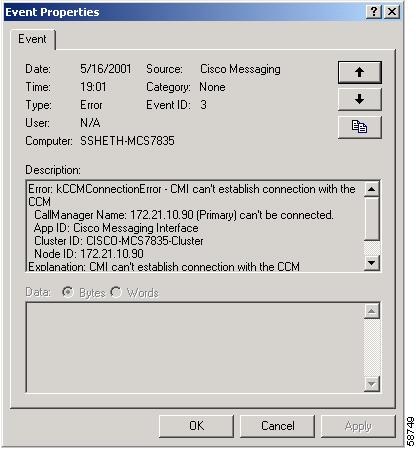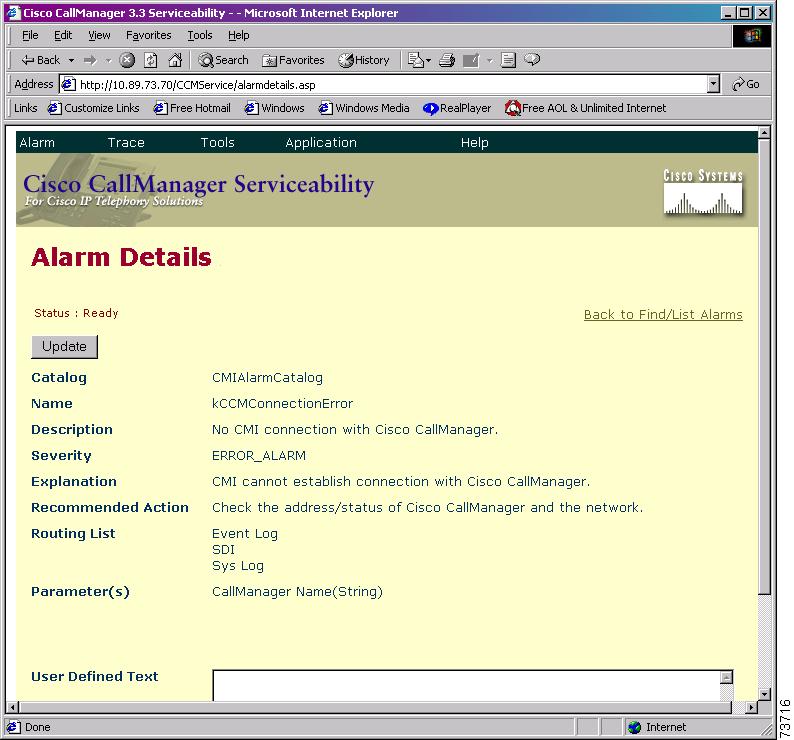

-
Cisco CallManager Serviceability System Guide, Release 3.3(3)
-
Index
-
Preface
-
Introduction
-
Objects and Counters
-
Cisco CallManager Services
-
Tools Overview
-
Service Activation
-
Control Center
-
Alarms
-
Trace
-
Real-Time Monitoring
-
Quality Report Tool
-
Microsoft Performance
-
Bulk Trace Analysis
-
CDR Analysis and Reporting
-
Remote Serviceability Overview
-
Cisco Secure Telnet
-
Show Command Line Interface
-
Simple Network Management Protocol
-
CiscoWorks2000
-
Path Analysis
-
System Log Management
-
Cisco Discovery Protocol Support
-
Cisco CallManager Perfmon Counters, RTMT, and CISCO-CCM-MIB
-
Trace Examples
-
Table Of Contents
Applications Using Registry-Based Alarm Interfaces
Alarm Definition Configuration Checklist
Where to Find More Information
Alarms
This chapter provides information on Serviceability Alarms and contains the following topics:
•
Alarm Configuration Checklist
•
Alarm Definition Configuration Checklist
•
Where to Find More Information
Understanding Alarms
Cisco CallManager Serviceability Alarms provides a web-based interface that configures alarms and events and provides alarm message definitions. Both functions assist the system administrator and support personnel in troubleshooting Cisco CallManager problems.
You use Alarms to provide run-time status and state of the Cisco CallManager system and to take corrective action for problem resolution; for example, to determine whether phones are registered and working. Alarms contain information such as explanation and recommended action. Alarm information includes application name, machine name, and cluster name to help you perform troubleshooting for problems that are not on your local Cisco CallManager.
You configure the Alarm interface to send alarm information to multiple destinations, and each destination can have its own alarm event level (from debug to emergency).
You can forward alarms to a Serviceability Trace file. An administrator configures Alarms and Trace parameters and provides the information to a Cisco TAC engineer. You can direct Alarms to the Win2000 Event Log, Syslog, an SDI trace log file, an SDL trace log file (for Cisco CallManager and CTIManager only), or to all destinations. Use Trace to collect and analyze the alarms.
When a service issues an alarm, the alarm interface sends the alarm to the chosen monitors (for example, SDI trace). The monitor forwards the alarm or writes it to its final destination (such as a log file).
Note
To log alarms in the SDI trace log file, check two check boxes in Trace configuration and one check box in Alarm configuration: the Trace on check box in Trace configuration, the Enable trace file log check box in Trace configuration, and the SDI alarm destination check box in Alarm configuration.
Alarm definitions describe alarm messages: what they mean and how to recover from them.
You search the Alarm definitions database for alarm information. When you click on any service-specific alarm, a description of the alarm information and a recommended action displays.
The following sections provide procedures for alarm configuration and alarm definition searches.
Alarm Configuration
You configure alarm information that will be used for Trace and troubleshooting. You can configure alarms for Cisco CallManager servers that are in a cluster and services for each server, such as Cisco CallManager, Cisco TFTP, and Cisco CTIManager.
Alarm Monitors
The alarm interface supports up to four alarm destinations, or monitors. The following monitors receive alarms:
•
Event Log
•
SDI trace (can be viewed in text or XML format)
•
SDL trace (can be viewed in text or XML format)
•
Syslog
See Table 7-1 for a description of the alarm monitors.
Alarm Filters
Filtering of alarm information occurs based on the alarm event level that was configured for an individual service and the monitor destination. Filtering accomplishes two tasks: helps the administrator narrow the types of alarms that Cisco CallManager collects and prevents the event log, Syslog, and trace files from becoming overloaded. See Table 7-2 for a description of alarm levels.
Viewing Alarm Information
You view alarm information to determine whether Cisco CallManager problems exist. Use the Event Viewer program to view alarm information that is sent to the Event Log. You can view alarm information that is sent to the SDI or SDL trace log file in text or XML format. Use Trace to view the SDI or SDL log files in XML format or use a text editor to view the SDI or SDL log files in text format. (Trace supports text format as well.) Use CiscoWorks2000 report viewer to view Syslog messages.
Microsoft Windows 2000 documentation provides detailed information about Event Viewer and Microsoft text editors.
Alarm Definitions
Cisco CallManager stores alarm definitions and recommended actions in a standard query language (SQL) server database. The system administrator can search the database for definitions of all the alarms. The definitions include the alarm name, description, explanation, recommended action, severity, parameters, and monitors. This information aids the administrator in troubleshooting problems that Cisco CallManager encounters. See Table 7-3 for a description of alarm catalogs.
See the following sections for more information related to alarm definitions:
•
Applications Using Registry-Based Alarm Interfaces
Applications Using Registry-Based Alarm Interfaces
The alarm interface library uses the database to get configuration information. A user changes and views configuration parameters and alarm definitions via the Cisco CallManager administration configuration web pages; therefore, only applications that have database access use the alarm interface library to generate alarms. However, applications that use registry-based alarm interfaces, such as all Java-based applications, do not require a separate user interface to allow the user to change the configuration parameters and to view alarm definitions. Instead, users can use the standard XML registry editor that is provided with their operating system to view and change the registry entries. Refer to your online OS documentation for more information on using the registry editor.
Editing an Alarm Definition
Serviceability Alarm Definitions allow administrators to add additional explanation or recommendations for an alarm. All administrators have access to the added information. Administrators directly enter information into the User Defined Text box that displays in the Alarm Details window. Standard horizontal and vertical scroll bars support scrolling. Cisco CallManager Serviceability adds the information to the database.
Alarm Definition Example
Figure 7-1 illustrates an alarm that is sent to the Windows 2000 Event Viewer and how that information correlates to Alarm Definitions (Figure 7-2).
Figure 7-1 Event Properties Window
Figure 7-2 Alarm Definitions Window
Alarm Configuration Checklist
Table 7-4 provides an overview of the steps for configuring alarms.
Table 7-4 Alarm Configuration Checklist
Step 1
Choose the server and service for which you want the alarm information.
Configuring or Updating an Alarm for a Service, Cisco CallManager Serviceability Administration Guide
Step 2
Choose the destination of the alarm:
•
All services can go to the SDI log (but must be configured in Trace also).
•
All services can go to the Microsoft Event Viewer.
•
If you are using CiscoWorks2000, check the Syslog destination and specify a host name.
•
Only Cisco CallManager and Cisco CTIManager use the SDL log.
Configuring or Updating an Alarm for a Service, Cisco CallManager Serviceability Administration Guide
Alarm Destination Settings, Cisco CallManager Serviceability Administration Guide
Step 3
Choose the alarm event level.
Configuring or Updating an Alarm for a Service, Cisco CallManager Serviceability Administration Guide
Alarm Event Level Settings, Cisco CallManager Serviceability Administration Guide
Alarm Definition Configuration Checklist
Table 7-5 provides an overview of the steps for configuring alarm definitions.
Table 7-5 Alarm Definition Configuration Checklist
Step 1
Choose an alarm from the Event Viewer.
Viewing Alarm Information in Text Format, Cisco CallManager Serviceability Administration Guide
Step 2
Look for the corresponding alarm definition for the description and recommended action.
Searching for and Viewing an Alarm Definition, Cisco CallManager Serviceability Administration Guide
Where to Find More Information
Related Topics
•
Configuring or Updating an Alarm for a Service, Cisco CallManager Serviceability Administration Guide
•
Applying an Alarm Configuration to All Nodes in a Cluster, Cisco CallManager Serviceability Administration Guide
•
Searching for and Viewing an Alarm Definition, Cisco CallManager Serviceability Administration Guide
•
Creating User-Defined Description in the Alarm Definition, Cisco CallManager Serviceability Administration Guide
•
Alarm Definition Catalog Descriptions, Cisco CallManager Serviceability Administration Guide
•
Viewing Alarm Information in Text Format, Cisco CallManager Serviceability Administration Guide
•
Viewing Alarm Information in XML Format, Cisco CallManager Serviceability Administration Guide
Additional Cisco Documentation
•
Troubleshooting Guide for Cisco CallManager

 Feedback
Feedback

